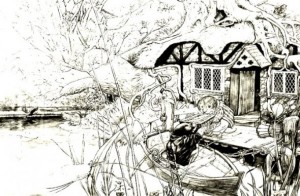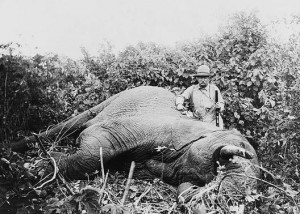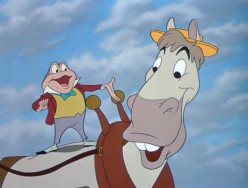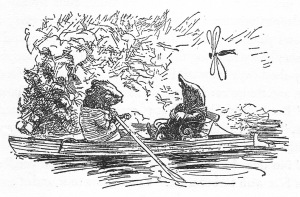
Today I started reading The Wind in the Willows, a wonderful classic tale about the society of animals that lives along the riverbank — including a mole, a badger, a rat, and a toad. It’s available as a free e-book in Amazon’s Kindle store. But it turns out the book has a fascinating history almost as good a story as the book itself.
Author Kenneth Grahame was the secretary of the Bank of England until the age of 49, according to Wikipedia. He hadn’t written a work of fiction in 10 years, but based the book’s most memorable character, Mr. Toad, on his enthusiastic eight-year-old son, Alastair. The book would become a fondly-remembered classic, mixing its funny story with adult allegories celebrating the joy of springtime and the beauty of the great outdoors. “When I was very young…” remembered one reviewer on Amazon, “our school master used to read to us from Wind in the Willows. The stories had a magical quality and a few weeks ago, as a somewhat older person, I got to wondering whether they would still have that sense of enchantment that held us so captivated all those years ago.
“I was NOT disappointed….”
Later A. A. Milne, the author of Winnie the Pooh, joked that “Reading these delicately lovely visions of childhood, you might have wondered that he could be mixed up with anything so unlovely as a bank; and it may be presumed that at the bank an equal surprise was felt that such a responsible official could be mixed up with beauty.” Grahame was in his mid-60s by the time Milne first published his first Pooh story, though Milne once wrote that “I feel sometimes that it was I who wrote it and recommended it to Kenneth Grahame.” Later, when Grahame was 70 years old, A. A. Milne adapted Grahame’s book into a stage play (called “Toad of Toad Hall”), and one night the two men even shared a theatre box together.
He sat there, an old man now, as eager as any child in the audience, and on the occasions (fortunately not too rare) when he could recognise his own words, his eyes caught his wife’s, and they smiled at each other, and seemed to be saying: ‘I wrote that’ — ‘Yes, dear, you wrote that,’ and they nodded happily at each other, and turned their eyes again to the stage.
Milne later wrote an introduction for the book, remembering that it “was not immediately the success which is should have been.” But he also remembers that almost instantly Grahame had attracted some impressive admirers. In 1909, in one of his last month’s in office, Theodore Roosevelt, the president of the United States, took time to write a personal letter in 1909 thanking Kenneth Grahame for his book. (“I felt I must give myself the pleasure of telling you how much we had all enjoyed your book…”) He’d been a bigger fan of Grahame’s earlier books at first, but wrote that “Mrs. Roosevelt and two of the boys, Kermit and Ted, all quite independently, got hold of The Wind in the Willows and took such a delight in it that I began to feel that I might have to revise my judgment.
“Then Mrs. Roosevelt read it aloud to the younger children, and I listened now and then. Now I have read it and reread it, and have come to accept the characters as old friends… Indeed, I feel about going to Africa very much as the seafaring rat did when he almost made the water rat wish to forsake everything and start wandering.”
Six weeks later, Roosevelt left office — and embarked on a safari of Africa.

Americans may remember that when Disneyland opened in the 1950s, one of its first rides (“Mr. Toad’s Wild Ride”) was inspired by Disney’s cartoon version of Grahame’s book. But what’s less-known is the trouble that Walt Disney had in filming the story. It was intended to be one of his studios first animated movies, just four years after Snow White (their first feature-length cartoon), according to Wikipedia. Unfortunately, the story’s plot violated the Hays Code, the notorious film-production guidelines which covered all American movies.
In the book, Mr. Toad ultimately steals (and crashes) a motor car. And while he goes to jail, he escapes, and remains a misguided but sympathetic character throughout the story. “The sympathy of the audience should never be thrown to the side of crime, wrongdoing, evil or sin,” the Hays Code insisted. Disney’s version ultimately had to be re-written so that Mr. Toad was instead wrongfully framed of stealing the motor car.
Unfortunately, World War II then interrupted the film’s production (as many of Disney’s animators were drafted into the military), while also putting a strain on the studio’s finances. In the end, it took eight years until a shorter version of the cartoon was released instead, with Mr. Toad’s adventures bundled with the animated version of another classic story — The Legend of Sleepy Hollow.

The seventh chapter of Grahame’s book — “The Piper at the Gates of Dawn” — proved to be especially popular. It describes the mole and rat searching for a lost animal, and instead having an almost religious experience when, off in the woods, they hear the distant music of Pan. It was the favorite chapter of A. A. Milne’s wife, remembers his son Christopher, who wrote that she “read to me again and again with always, towards the end, the catch in the voice and the long pause to find her handkerchief and blow her nose…” And 60 years later, in 1967, the rock band Pink Floyd used its title as the name of their debut album.
But here’s the most lovely piece of trivia about the book. Apparently because of his books’ popularity, Grahame was eventually able to retire to the countryside by the River Thames.
And he was finally able to enjoy the idyllic county life that he’d described so lovingly for his own characters.

Visit http://tinyurl.com/MrToadEbook for
the free e-book version
or click here